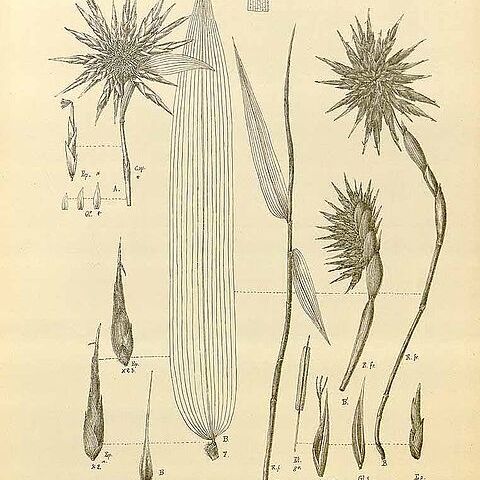A bamboo or grass. It grows 10-15 m high. It grows in dense clumps. The stem is solid. It is 8-10 cm wide at the base. It arches slightly at the tips. The sheaths are covered with short dark brown bristly hairs. These can be rubbed off. (They irritate the hands). The leaves are bluish green and narrowly sword shaped. They are 5-25 cm long by 1-3 cm wide. They taper to a spine tipped point. The flowers occur in 1-4 flowered spikes. The upper flowers are of both sexes. The lower flowers are sterile. The grains narrowly taper to both ends. After flowering the clump dies back to re-shoot from the base.
Clump-forming, woody bamboo to 10 m high; rhizomatous; culms 50-100 mm in diameter, drooping; culm sheath with dense brown hairs on inner surface, auricles absent; branches clustered at nodes. Leaf blade 50-250 x 10-30 mm. Inflorescence globose, spiky. Spikelet 15-45 mm long, pungent; glumes and sterile lemmas shorter than spikelet; bisexual lemma ± as long as spikelet.
Culms up to 13 m. tall, 5-10 cm. in diam., many-noded, erect, densely covered with appressed hairs when young, later glabrous, solid or thick-walled; culm-sheaths covered with dark-brown stiff hairs; lamina 1-2 cm. long, involute, pungent.
Rhizomatous, up to 10 m high (culms 50-100 mm in diameter). Bamboo with drooping culms and clustered leaf-bearing branches; sheaths of culm leaves with dense hairs on inner surface. Leaf blades 50-250 mm long, 10-30 mm wide.
Lemmas narrowly lanceolate, dorsally hispidulous; the lower 1·2-2 cm. long; the uppermost almost as long as the spikelet, tapering into a rigid spine up to 7 mm. long.
Spikelet clusters 4-8 mm. in diam., globose, often apparently confluent, spiny; bracts up to 4 mm. long, ovate, dorsally rounded but the lowermost 2 keeled.
Glumes ovate to oblong, apex obtuse to acute, usually scattered with short stiff hairs; the inferior 5-8 mm. long; the superior 8-10 mm. long.
Leaf-laminae 5-25 x 1-3 cm., linear-lanceolate to lanceolate, tapering to a fine pungent point, inconspicuously tessellate, glaucous.
Spikelets 1·5-4 cm. long, 1-4-flowered, very narrowly lanceolate.
Leaf-sheaths without auricles, with a few setae near the collar.
Palea slightly shorter than the lemmas, narrowly lanceolate.
Culms up to about 6 m. high and 5 cm. diam.
A robust bamboo, growing in dense clumps.
Stems thick-walled, almost solid

